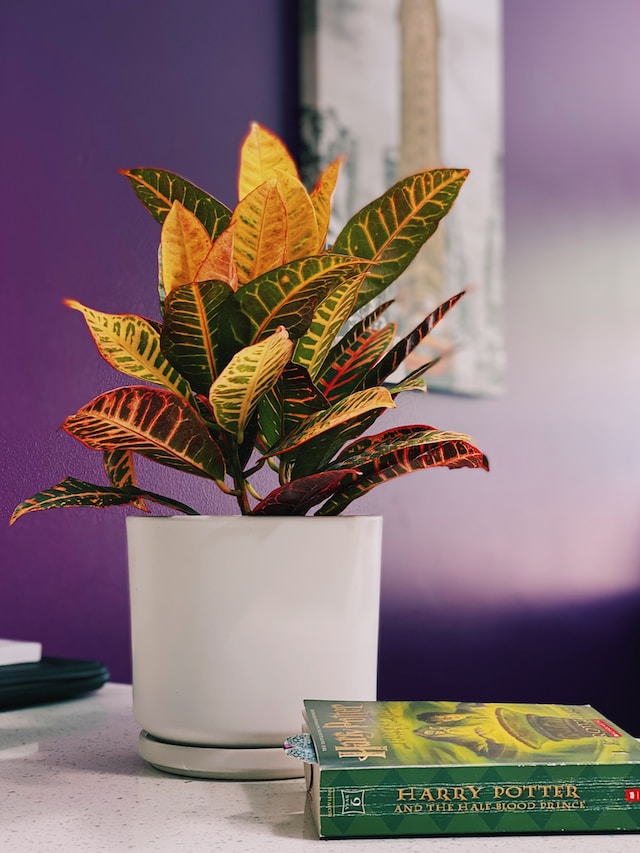
Croton plant biological name is Codiaeum variegatum. It is a small tree or shrub commonly cultivated as an ornamental garden or plant for pots. A large number of varieties are available that vary in leaf scale, shape, and color. Croton is native to the tropical forests of Southeast Asia and Oceania and is also called garden croton. They grow as large shrubs in the wild, reaching up to 10 feet high (in the home or garden, they stay small).
PLANT ESSENTIALS
1. Fertilizers:
To grow, the Croton plant desires humus-rich soil. Use a 3-1-2 liquid chemical to feed the plant once every week. If you discover that the plant is foodless despite regular feeding, increase the number of chemicals. However, keep an in-depth watch as it does not prefer to be nourished and can tell you the maximum amount through uninteresting leaves.
2. Repotting:
Repot the Croton Petra once a year for the first three years. After that, Repot when the roots have outgrown the pot. While repotting, use a vessel that is 2 inches wider than the current one and use fresh soil rich in humus.
Croton Plant Care
1. What temperatures do croton plants tolerate?
Having stemmed in a tropical climate, croton plants prefer warm conditions. If temperatures let fall too far below 55, the plants’ leaves may begin to become brown. Ideally, the Croton plant will do its finest at 80 or below temperatures, as the plant will not survive in extreme heat.
2. How often should Croton plants be watered?
Again, the Croton plant stemmed in a tropical environment, favoring a warm, humid climate. The soil in which the croton arises should remain wet but not always wet during spring and summer when the plant is growing. Feel the earth, and if it is dry to the touch, it may be time for watering. In a dry climate, the croton requires misting to regulate healthy leaf growth.
3. How much light do Croton plants need?
Croton plants prefer full-length sun, but depending on the species, some can endure limited shade. The total amount of sun that the plant receives will correspond to the intensity of its color. To attain full, vibrant color, the plant should remain in good light.
4. What kind of soil is appropriate for Croton plants?
Croton plants grow best in soil, allowing for adequate draining while still maintaining enough moisture to promote growth. If the growing means retains too much water, the plant may become subject to root rot.
5. How do you propagate Crotons?
To propagate a croton plant, use a stem cutting that is 3-4 inches in length and must possess 3 to 5 leaves. The cutting in an off-the-shelf rooting hormone and plant in a compact pot. Keep the soil moist but not overwatered. Cuttings will root in less than a month if temperatures stay between 70°-80°F.
Common Problems:
1. Why my Croton plant is wilting, and leaves are dropping?
If there is a change in the location of the Croton plant, then it can cause leaf loss. But no need to stress, have patience! in 3-4 weeks the plant will get fresh and tender leaves again.
You must be watering your plant improperly if your Croton plant leaves are wilting. Make sure that your water according to the requirements.
2. How am I supposed to make Croton Petra bushy?
Croton plants should not get exposed to indirect bright sunlight and humidity in optimum conditions. You need to water the Croton plant when you notice that the soil in the top inch is dry. If observed that the plant is still losing leaves, then prune it back to foster new branching and growth.
Style and décor:
Decorate indoors – A plant adds so much life to the house style and décor and is an ideal way to decorate indoors, mostly if the interiors are in monochromatic and muted natural tones.
Window boxes:– They are also significant to pep up the look of any window. Use a window planter for creating a Croton planter base; you can also add other plants for variety. So who wants the same old dull window look when you have such a great idea to jazz it up? Whenever you look out of the window, it will surely bring a smile to your face.
Conclusion
In short and in conclusion, Croton plants offer some aspirations for generating low-cost biofuels with lesser emissions. Thus, they can help lower emissions and reduce climate change, all without the many or with minimal problems associated with other biofuel sources such as the palm oil tree and Jatropha.